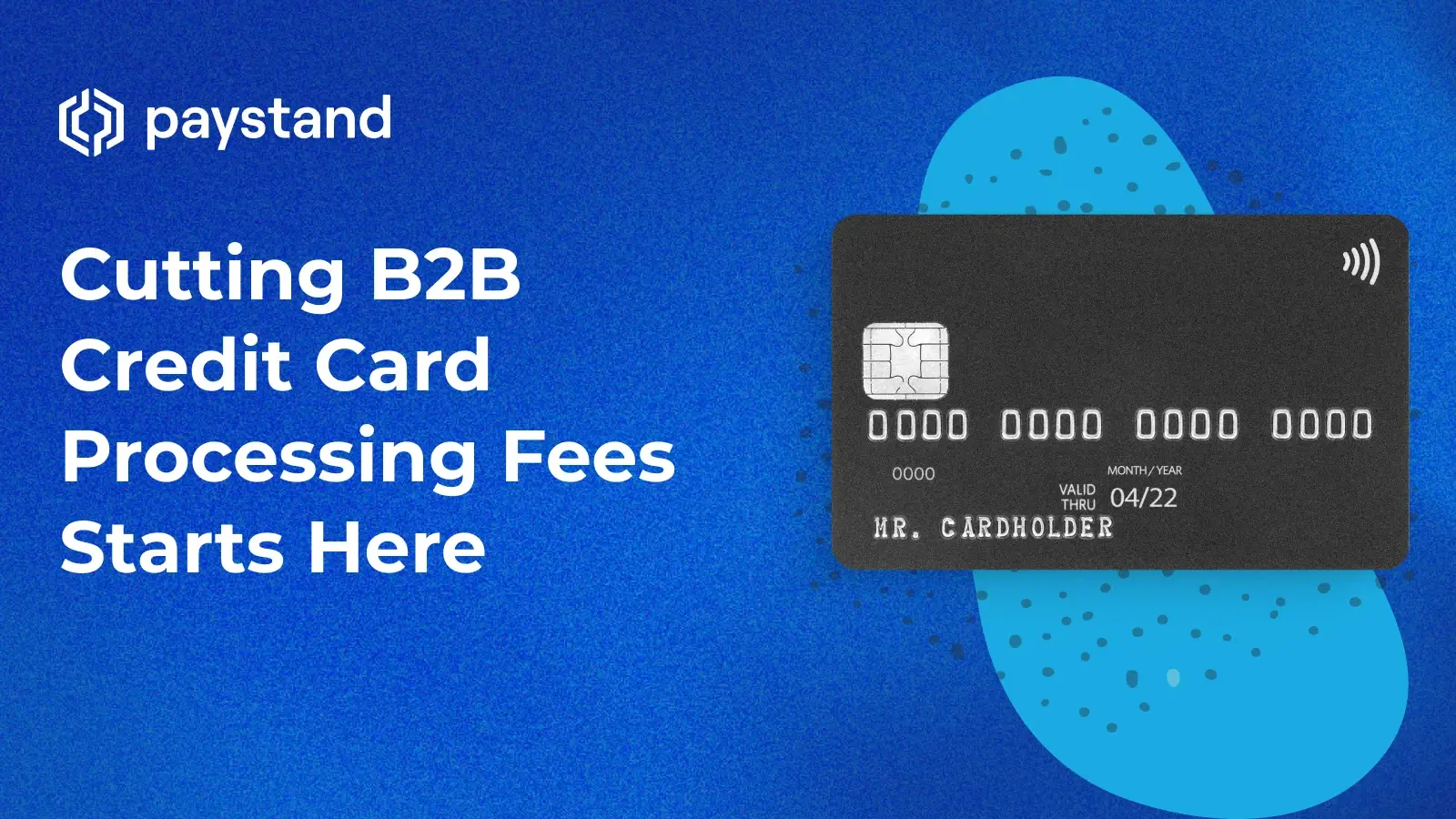Cutting B2B Credit Card Processing Fees Starts Here

Table of Contents
- What are the charges for B2B credit card payments?
- How are B2B credit card processing fees decided?
- What factors influence interchange rates?
- Strategies to reduce credit card processing fees in B2B
- How Paystand is changing the credit card fee game
- The bigger picture: a new financial system
Key Takeaways
- B2B credit card processing fees often exceed 3.5%, driven by opaque interchange rates, assessment fees, and processor markups that erode profit margins.
- These fees are influenced by card type, payment method, pricing model, risk profile, and data level use, making them highly variable and difficult to manage.
- Paystand disrupts the credit card system with zero-fee payments via its blockchain network and tools for managing surcharges and payment routing.
- The future of B2B payments lies in eliminating outdated, fee-heavy systems and embracing decentralized finance infrastructure that empowers strategic financial operations.
Credit cards are considered a “fast and easy” payment method for businesses, but reviewing your monthly merchant statement reveals that “easy” has a cost that isn’t transparent. For B2B companies, credit card processing fees are a growing margin burden. With interchange fees, assessment fees, and third-party gateway costs, the real expense of accepting card payments can exceed 3.5% per transaction.
As companies move from paper checks to digital B2B payments, commercial card use and scrutiny increase. Finance teams question high credit card fees despite technology's efficiency. Notably, Visa and Mastercard frequently raise rates, while American Express maintains premium merchant fees.
Let’s explore the real cost drivers of B2B credit card processing fees, the factors influencing rates, and strategies to reduce them. What if credit card fee structures are outdated? Discover why the future of B2B finance doesn't have to rely on legacy payment systems.
What Are the Charges for B2B Credit Card Payments?
Credit card processing fees can be significantly higher in B2B transactions than in consumer retail environments. B2B payments are often larger, more complex in compliance, and typically involve corporate cards that fall into higher-rate categories.
Here’s what makes up the bulk of those fees:
- Interchange fee: This is paid to the issuing bank (the cardholder’s bank) and varies by card type (corporate, purchasing, rewards), payment method, and whether the transaction includes extra data III).
- Assessment fee: Collected by credit card networks, this is usually a small percentage of the transaction.
- Processor/payment gateway fee: Your provider adds these based on your pricing model (interchange-plus, tiered, or flat fee).
These fees represent credit card processing rates. In B2B, businesses typically pay 2.5% to 4% per transaction, sometimes more. Multiply this by millions in annual revenue to understand the impact on profitability.
How Are B2B Credit Card Processing Fees Decided?
Unlike consumer transactions, B2B credit card processing involves many factors that contribute to total fees. Finance teams are often frustrated by these fees, which are often non-negotiable and unpredictable. Your fees depend on key inputs that feed into a complex pricing ecosystem.
1. Interchange Rates
Interchange rates, set by credit card networks like Visa, Mastercard, and American Express, form the basis of your total processing cost. These non-negotiable rates go directly to issuing banks, which provide credit cards to customers. They cover risk, rewards, and administrative costs, but trap merchants in a system where every transaction may incur hidden margin loss.
2. Pricing Model
Your payment processor determines how you’re billed for each card transaction and whether you see the underlying interchange and assessment fees. Here are the main models:
- Tiered pricing: Transactions are classified as “qualified,” “mid-qualified,” or “non-qualified”, often without explanation. This model obscures true payment processing costs, with most B2B transactions falling into the non-qualified (highest cost) category.
- Interchange-plus: A transparent approach with actual interchange fees plus a fixed flat fee or percentage markup. While fairer, this model exposes you to fluctuating fees from external factors.
- Flat Fee Pricing: This model provides simplicity: one rate for all. However, it may hide overpayment, particularly on low-cost transactions. It sacrifices visibility for convenience, which can disadvantage high-volume merchants.
3. Risk Profile
Card networks and processors assess risk based on industry, customer behavior, and transaction patterns. Businesses with high chargeback rates or in high-risk verticals (travel, supplements, or SaaS) face significantly higher credit card processing rates.
Likewise, person-to-person transactions, international payments, and high-dollar-value transactions are seen as riskier. They may be routed through additional verification or fraud detection layers, each adding another cost to the transaction.
What Factors Influence Interchange Rates?
Interchange fees vary; there’s no flat rate. They’re dynamic, multi-variable, and intentionally confusing. The interchange fee is the largest, least transparent part of total credit card processing fees, determined by:
Card Type
A standard debit card has a much lower interchange fee than a corporate rewards card. Corporate cards incentivize spending through rewards and perks, which create higher merchant fees. Standardized for its premium services, American Express typically charges the highest credit card processing fees across all networks.
Payment Method
The transaction method greatly affects risk and fees. In-person card payments have the lowest risk and interchange rates. Remote or manual card transactions, often in B2B, carry higher risks and fees. Recurring payments and those through virtual terminals face elevated rates due to fraud concerns.
Data Leveling: Level II and III Transactions
Leveraging Level II and III data can yield significant savings. By providing detailed information, such as tax amounts, item descriptions, and purchase order numbers, B2B merchants can access lower interchange fees. These levels are designed for commercial transactions, but many businesses remain unaware or use outdated systems.
Merchant Category Code (MCC)
Your industry classification significantly impacts rate assignment. Some MCCs are deemed riskier and incur higher fees and interchange rates. Updating your MCC can result in immediate savings, provided your payment processor supports it.
Transaction Size and Frequency
B2B transactions are often high-value, infrequent, or invoice-based. Ironically, this creates more volatility in interchange pricing. Large transactions that fall outside of typical consumer behavior patterns can trigger fraud flags and add layers of cost.
Interchange fees are designed to protect card issuers and networks, not to help your bottom line. But understanding these triggers gives you the power to minimize exposure and explore more sustainable payment options.
Strategies to Reduce Credit Card Processing Fees in B2B
Reducing credit card processing fees doesn’t require becoming a payments expert overnight. It involves asking the right questions, using the right tools, and rethinking your default settings. The good news is that B2B businesses have more leverage than ever.
1. Pass Fees to Customers
Businesses often pass these fees to customers through compliant surcharging. Many buyers switch to methods like ACH to avoid extra costs from contracts. Ensure your system manages this transparently, as some jurisdictions require disclosing these fees. Platforms like Paystand automate the calculation and presentation of these fees at checkout or invoice payment.
2. Optimize for Level II and III Data
If you process many card transactions without using Level II or III data, you risk overpayment. Enhanced data capture can lower interchange rates, particularly for corporate cards. This usually requires modern payment software or an ERP-integrated gateway that supports enhanced data fields. For instance, Paystand automates this through its smart routing, ensuring you qualify for the lowest rate when card payments are necessary.
3. Incentivize Low-Cost Payment Options
Shift customer behavior, not just fees. Encourage lower-cost options like bank transfers, Paystand’s Zero-Fee Network, or digital rails through early payment discounts, tiered terms, or clear fee communication. Make these options easy to select and more beneficial than card payments. Reduce friction for a smoother transition, ensuring it lasts.
4. Audit Your Payment Processor
When did you last check your processing agreement? Many businesses sign with a provider, accept the flat fee, and never revisit it. Hidden fees, like PCI charges, monthly minimums, gateway fees, etc., can diminish your margins over time. Request an itemized report, compare competitors, and question every line. Better yet, find a provider that doesn’t profit from interchange.
How Paystand Is Changing the Credit Card Fee Game
B2B credit card fees have hidden costs, outdated structures, and misaligned incentives. What if you didn’t have to optimize the system? What if you could replace it? That’s what Paystand is doing.
Traditional payment processing relies on interchange and assessment fees, alongside various markups in the credit card system. In contrast, Paystand’s model utilizes decentralized finance, allowing merchants to bypass card networks and achieve zero-fee payments. This leads to businesses retaining more earnings and finance teams working efficiently with their tools.
Here’s how Paystand reshapes payment processing costs and helps you reclaim your margins:
- No fees: Paystand eliminates credit card processing costs by routing payments through its Zero-Fee Network.
- Integrated credit card surcharge tools: Built-in tools allow you to pass convenience fees legally to customers, ensuring compliance while managing fees on your terms.
- Automated payment gateway with incentives: The platform promotes low-cost methods like ACH and direct debit through prompts and incentives, easing customer transitions from cards.
- ERP control of terms and methods: Your ERP system manages payment details, leading to smarter routing, fewer transactions, and lower processing rates.
- Blockchain and smart contracts ensure payments are traceable, tamper-resistant, audit-ready, and automated, eliminating the need to chase invoices or reconcile data.
With the 1.99% credit card flat-rate, Paystand helps businesses cap costs when cards are necessary. It offers the lowest guaranteed surcharge rate in the market and integrated tools to promote non-card usage and lessen reliance on traditional methods.
This isn't just an evolution; it's a financial revolution.
The Bigger Picture: A New Financial System
Let’s call this the beginning of the end for archaic, fee-laden, bank-first finance. Blockchain, smart contracts, AI automation, and decentralization are now essential infrastructure and the new status quo.
If your business still pays high merchant fees, absorbs excessive interchange costs, or accepts that passing credit card fees to customers is a messy compliance headache, there is another way.
Paystand doesn’t just save you money. It shifts your entire finance team from the swamp of manual reconciliations and fee justifications into a world of strategic, mission-aligned finance. It puts you on a path where payments are a source of leverage, not loss.
So if you’re still playing by legacy rules, ask yourself: Why? What if your finance team had zero transaction fees? What if your customers chose the lowest-cost payment option every time? What if your CFO didn’t need to trade growth for cost containment?
What if everything you knew about credit card processing was wrong? It’s time to find out. Join the movement.





